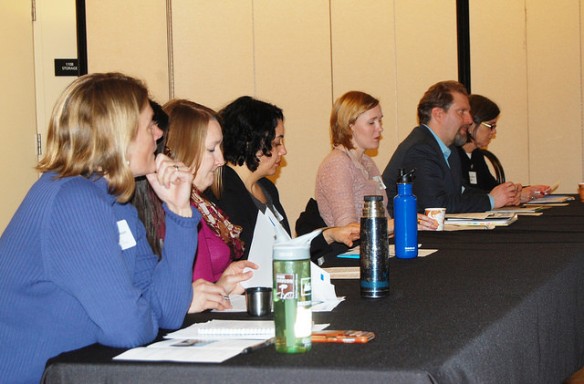A huge thank you to the more than 70 attendees participated in the Intertwine’s Active Transportation Forum on January 27 at PSU’s Native American Cultural Center, where many great conversations were had. Folks from planning, advocacy organizations, health, environment, trails, finance, and more came together to help solidify the answer to the question, If active transportation projects are of regional significance, how can we better define them to succeed?
An ever-increasing body of research confirms the direct connection between transportation options and job growth, economic vitality, and human and environmental health. Frequently, however, transportation funding conversations dismiss walking and bicycling as local concerns that have little regional impact, meaning we do not make headway when it comes to building projects.
We heard from a panel of eight great presenters who each “made the case” from a unique perspective, of how we can and should re-think walking, bicycling, and transit trips:
- Jenny Cadigan, Executive Director, WTA – Reducing drive alone commute trips
- Lynn Weigand, Project Coordinator, East Multnomah County Bicycle Tourism Initiative, Gresham Chamber of Commerce – Projects that add up to Bicycle Tourism
- Eric Hesse, Strategic Planning Coordinator, TriMet – Access to transit: the last mile of a regional trip
- Shelley Oylear, Bicycle and Pedestrian Coordinator, Washington County – Suburban greenways retrofitting the suburbs: regional impact of a network
- Jessica Horning – Transit and Active Transportation Liaison, ODOT Region 1 – 82nd Ave/Jade District corridor: When a main street is regional
- Jenna Stanke Marmon, Bicycle & Pedestrian Program Manager, Jackson County Roads & Parks – Connect Oregon and the statewide economic benefits of active transportation projects
- Amanda Garcia-Snell, Health Promotion Supervisor, Washington County – Reducing health care costs, increasing safety
- Mary Kyle McCurdy, Policy Director and Staff Attorney, 1,000 Friends Oregon – Why active transportation was included in a state transportation funding proposal
Special thanks to Craig Beebe from Metro for serving as “documentarian” and to Luann Algoso from APANO for filming the forum.
What’s next?
“I’ve already been using some of the concepts we talked about in various conversations.”
Over the next few months, the comments and ideas gathered during the January 2015 How We Get There Matters Forum will be analyzed and refined into a report back that will be made public here.
“Multiple threads from the day’s discussion continued on outside the room and on down the street.”
We know there is a great need to continue these conversations, and to add to them, which was confirmed by the energy in the room as well as the difficulty keeping the conversation to one topic at a time. We are already at work planning the next forum, and welcome your input. Please email Kari if you are interested in getting involved.
“We should be done asking this question. We need to be more productive.”
One participant’s statement hung in the air that really got at the heart of why The Intertwine, Metro, the Safe Routes Partnership, and Portland State University’s Initiative for Bicycle and Pedestrian Innovation brought this forum together. We very much look forward to keeping this conversation going, and being more productive. Thank you for attending, and we look forward to continuing this work with you.
Dropbox link to the presentation here (large pdf).
How did we get here?
For a bit of recent history, we look back. In September 2013, a Regional Walkability Summit was held in Beaverton. The Walkability Summit convened local experts, decision makers and other stakeholders from communities around the state – including many who attended this first How We Get There Matters forum. That group came together to discuss how we could make real change to increase active daily lifestyles and physical activity and improve walkability through environmental change strategies, especially in underserved communities.
Since then, we have seen a renewed interest and commitment to improving walkability. A few examples of what has happened in the past year:
- The City of Tigard has declared its desire to become the “most walkable community in the Northwest”;
- The City of Milwaukie has taken steps toward improving its walkable and bikeable connections by focusing on two things: the improvements coming to town via the new Portland-Milwaukie Light Rail line; and filling in gaps in the walking and bicycling network in the area directly around Milwaukie schools;
- Metro regional government passed first-of-their-kind Regional Active Transportation Plan and tailpipe-emission-reducing Climate Smart Strategies;
- Bicycle and pedestrian projects were eligible for the first time ever for state “ConnectOregon” funding, which totaled more than $42 million in 2014; and
- The Intertwine Alliance held a summit in Spring 2014 with a focus that included Active Transportation.
While we have, individually and collectively, done a remarkable number of things to improve walkability, bikeability, and active transportation access – the fact remains that, here in the Metro region, we have much more to do:
- The 2010 mode share for walking and bicycling trips was 12%;
- Our regional goal is to triple the mode share for walking and bicycling to 36% by 2040;
- Currently, approximately $10 million is spent annually on stand-alone pedestrian, bicycle, and trail projects, which represents just 3% of the $433 million federal and state capital funds spent annually on transportation in the region; and
- Only 55% of all roadways in the regional pedestrian network have sidewalks on both sides of the road.



